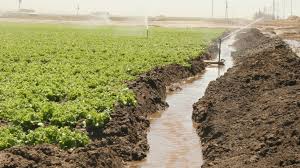The pressure for survival and the increasing need for food supplies due to population growth are driving the rapid expansion of irrigation worldwide. Irrigation is essential not only in arid regions but is also becoming important in humid areas.
While irrigation plays a significant role in well-developed agriculture globally, it also poses challenges. It can turn productive farmland into waterlogged areas, leading to salinity issues. Effective crop cultivation relies heavily on proper drainage of the land where crops are grown.
This article addresses all aspects of irrigation and drainage, including methods, advantages, and disadvantages, and discusses the suitability of each method based on crop type and land topography.
Definitions: Understanding Key Terms in Irrigation
Irrigation refers to the artificial application of water to the soil to provide moisture essential for plant growth. It supplements water from rainfall.
Read Also: Bombay Cat Breed Description and Complete Care Guide
Important Terms and Definitions in Irrigation
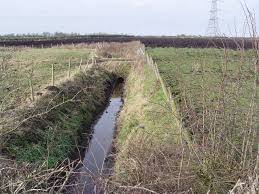
1. Water Requirement: The water requirement (WR) of a crop is the amount of water, from any source, necessary for the crop’s normal growth and development under field conditions.
WR includes losses due to evapotranspiration (ET) or consumptive use (CU), application losses, and water needed for special operations such as land preparation and transplanting. WR can be expressed as:
WR = ET or CU + application losses + special needs.
2. Irrigation Requirement: The field irrigation requirement (IR) of a crop is the water required by the crop, excluding effective rainfall and contributions from the soil profile. It is calculated as:
IR = WR – (ER + S).
3. Net Irrigation Requirement: This is the amount of irrigation water needed to bring the soil moisture in the effective root zone to field capacity. It is the difference between field capacity and the soil moisture content before irrigation.
4. Gross Irrigation Requirement: Gross irrigation requirement refers to the total water applied through irrigation, which includes net irrigation requirement plus losses during application. It is determined by dividing the net irrigation requirement by irrigation efficiency. For example, if the net irrigation requirement is 10 cm and irrigation efficiency is 70%, the gross amount of water to apply is:
10 cm / 0.70 = 14.29 cm.
5. Irrigation Efficiency: Irrigation efficiency measures how much water delivered through irrigation actually reaches the plant roots. For example, if the rooting depth is 1.5 m, the soil should ideally be wetted to at least 4 m. Irrigation efficiency measures how closely this ideal is achieved, varying by soil type. The ratio of water requirement to irrigation requirement indicates irrigation efficiency.
Factors Influencing Irrigation Efficiency
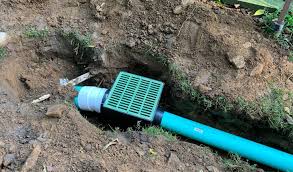
Irrigation efficiency depends on several factors:
1. Design of the irrigation system: Proper design ensures effective water distribution.
2. Degree of land preparation: Well-prepared land minimizes water loss.
3. Skills and care of the irrigator: Proper management reduces inefficiencies.
Water losses occur through evaporation, seepage, deep percolation, and run-off. For example, high evaporation in sprinkler systems lowers efficiency.
Minimizing Irrigation Water Loss
Water losses can be reduced through:
1. Adequate irrigation system planning: Proper planning ensures efficient water use.
2. Proper design of irrigation methods: Tailoring methods to the specific needs of the field prevents waste.
3. Proper land preparation: Preparing land reduces water loss.
4. Efficient system operation: Ensuring optimal operation limits unnecessary water use.
Irrigation Frequency
Irrigation frequency refers to the number of days between two irrigations during dry periods. It depends on the crop’s water use, soil moisture, and climate. Sandy soils require more frequent irrigation than fine-textured soils. In general, irrigation should start when about 50% of the available moisture is used.
Irrigation Scheduling
Irrigation scheduling varies widely by crop. Traditional scheduling was based on soil moisture levels, but the concept has evolved to consider climatic factors, such as evapotranspiration. The latest approach involves monitoring the plant’s water status, as plants integrate soil, water, and climate factors.
Crop Response to Moisture Levels at Different Growth Stages
Water requirements differ across crop growth stages. When water is limited, irrigation should be prioritized during critical growth stages to avoid significant yield loss. Critical stages are when crops are most sensitive to moisture shortages. Each crop has specific critical stages where a water deficit drastically reduces yield.
Critical Stages of Crop Growth in Relation to Moisture Availability
| Crop | Critical Periods |
|---|---|
| Wheat | Crown root initiation, heading, flowering, grain formation |
| Rice | Tillering, heading, flowering |
| Maize | Early vegetative stage, flowering, milk ripe stage (tasseling to hard-dough stage) |
| Sorghum | Seedling, booting to heading stage |
| Groundnuts | Flowering, pod development |
| Cotton | Start of flowering, boll development |
Source: (Onwueme, I.C. and Sinha, T. D. 1999)
This table highlights the critical stages of various crops, which must be managed carefully to ensure optimal water use efficiency during periods of moisture stress.
Read Also: Bombay Cat Breed Description and Complete Care Guide
Irrigation Methods and Their Suitability in Agriculture
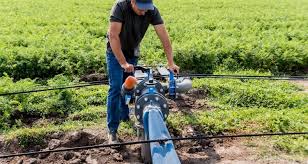
Irrigation methods vary widely due to differences in soil types, topography, water availability, crops, and local farming customs. These methods can be broadly classified into four categories:
1. Surface Irrigation Methods
Surface irrigation involves applying water directly to the soil surface from a channel positioned at the higher point of the field. Efficiency in this method depends on various factors like the size of the irrigation stream, soil infiltration rate, bed shape, and plant population. Common techniques include:
i. Flooding: Water is applied to the soil, covering it completely. It’s typically used for crops like rice.
ii. Check Basin Method: Water is applied in enclosed basins divided by ridges. It’s suitable for grains and orchards with slow infiltration rates.
iii. Border Strip Method: Water flows in thin sheets between low ridges over well-leveled land, ideal for wheat, barley, and fodder crops.
iv. Furrow Method: Small channels convey water between crop rows. It’s widely used for crops like maize, sorghum, and cotton.
v. Corrugation Method: Water flows through small furrows, suitable for steep slopes and fine to moderately coarse soils.
Advantages of Surface Irrigation
Surface irrigation is adaptable to nearly all soils and crops, and it is cost-effective, especially where water can be applied by gravity flow. However, it requires careful land preparation for maximum efficiency.
2. Overhead Irrigation (Sprinkler Irrigation)
In sprinkler irrigation, water is applied above the ground in the form of a spray. The system consists of pumps, main lines, laterals, and sprinkler heads or perforated pipes. Sprinklers distribute water uniformly across the field, making them suitable for terrain unsuitable for surface irrigation.
Advantages of Sprinkler Irrigation
This method is highly efficient, can be used on almost all crops (except rice and jute), and allows for the uniform application of water, fertilizers, and pesticides. It also reduces the need for field ditches, conserving space for crops. Sprinklers help prevent frost damage and can optimize the micro-climate during hot weather, improving crop health.
Disadvantages of Sprinkler Irrigation
The initial investment is high, and water loss through evaporation and wind can be significant. It is not ideal for areas with heavy clay soils or very windy conditions.
3. Sub-Surface Irrigation
This method delivers water below the soil surface, targeting the root zone directly. It’s beneficial for areas where surface water loss is a concern.
4. Drip Irrigation
Drip irrigation involves applying water directly to the root zone of plants in a controlled manner, minimizing evaporation and runoff. It is suitable for water-scarce regions and high-value crops.
Subsurface Irrigation
Subsurface irrigation involves applying water below the ground surface by maintaining an artificial water table at a predetermined depth, based on soil texture and the depth of plant roots. Water reaches the plant roots via capillary action, using either open ditches or underground pipelines like tile or mole drains.
These systems ensure even distribution, with open trenches spaced 30-100 cm deep and 15-30 meters apart. The system uses field channels and ditches for efficient water application and drainage.
A. Types of Subsurface Irrigation
1. Open Ditches System: This method involves feeder ditches excavated on contour lines, spaced to control the water table, and connected to a supply ditch. Excess water is drained through tile outlets.
2. Perforated Tubes (Drip Irrigation): Perforated tubes buried 4-8 inches underground pump water at low pressure, supplying moisture directly to the roots. Commonly used for row crops like cotton, this method reduces water wastage and is easy to install and remove.
Advantages of Drip Irrigation
i. Water savings are achieved by targeting the root zone without wetting the entire field.
ii. Fertilizers can be applied through the system, increasing nutrient efficiency.
iii. Losses due to evaporation, runoff, and deep percolation are minimized.
iv. The system is easy to install and remove post-harvest, making it versatile for various crops.
B. Suitability of Subsurface Irrigation
This method is suitable for soils with low water-holding capacity and high infiltration rates, where water can move efficiently both horizontally and vertically. It’s commonly used for vegetables, small grains, forage crops, and flowers.
Advantages of Subsurface Irrigation
i. Effective on soils with low water-holding capacity and high intake rates.
ii. Reduces weed dispersion, lowering weed control costs.
iii. Minimal evaporation from the land surface.
iv. Less frequent land preparation needed, preserving soil structure.
v. Water control allows for even distribution, with no interference to normal farm operations.
Disadvantages of Subsurface Irrigation
i. Salt accumulation in the root zone can occur.
ii. Requires specific physical conditions not easily found.
iii. Intensive drainage and leaching practices are needed for salinity control.
iv. High cost, justifiable only for high-value crops.
Water Management in Irrigation Schemes
A comprehensive irrigation development program must include the following elements:
1. Integrated Development of Water Resources: This involves watershed management and water harvesting, minimizing losses through seepage and evaporation. Lining reservoirs with materials like plastic or rubber helps retain water.
2. Efficient Water Conveyance and Distribution: Channels should be stable and free from sediment deposition. Lining canals with materials like concrete and plastic reduces weed growth and ensures smooth water flow.
3. Judicious Water Application: Proper water use involves applying the right amount to wet the root zone without over-saturating the soil.
4. Proper Soil Management: Land grading, preparation, and cultivation help ensure uniform water distribution, rainwater storage, and improved soil structure for better water retention.
5. Cropping Patterns for Efficiency: Efficient cropping patterns should prioritize short-duration, low-water crops that respond well to fertilizers and yield high outputs.
6. Proper Timing of Irrigation: For crops like rice, managing water use during the growing season prevents unnecessary water loss through percolation.
7. Removal of Excess Water: Excess water must be drained efficiently to prevent waterlogging and soil damage.
Drainage Systems
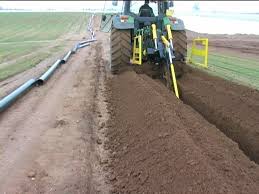
Drainage involves controlling and removing excess water from the soil and subsoil to maintain healthy crop conditions. Excess water can come from seepage, deep percolation, flooding, or groundwater flow.
A. Aims of Drainage
Drainage aims to rid the soil of excess water, improving aeration, temperature, and moisture within the crop root zone. Methods include improving natural drainage and providing artificial systems such as open drains or underground pipes.
B. Benefits of Drainage
i. Promotes better soil aggregation, aeration, root development, and nutrient uptake.
ii. Increases soil moisture availability, prevents nitrogen loss, and reduces soil erosion.
iii. Leaches excess salts and improves soil temperature, which boosts plant growth.
C. Types of Drainage Systems
1. Surface Drainage: This involves smoothing the soil surface and creating slopes to ensure water runoff. Ditches are constructed to remove water, though maintenance challenges and interference with machinery are potential drawbacks.
2. Subsurface Drainage: Mole drains are dug at a pre-arranged depth below the root zone, allowing water to pass through. Tile drains use concrete or clay pipes laid in trenches to collect excess water and discharge it through outlets.
Advantages of Subsurface Drainage
i. Lower maintenance costs.
ii. Does not obstruct farm equipment.
iii. Prevents land sacrifice, and the system indirectly assists irrigation.
iv. Protects soil from erosion by managing water effectively.
Maintenance of Drains
Drain maintenance involves regular cleaning of soil and vegetation from drainage systems. Periodically, chemicals may be added to prevent root intrusion in closed drains, ensuring the system remains effective.
Both irrigation and drainage play critical roles in sustainable crop production. While irrigation ensures crops receive adequate moisture, drainage prevents waterlogging, encouraging healthy soil conditions.
By applying the right techniques, farmers can optimize water use, improve soil health, and boost crop productivity.
Do you have any questions, suggestions, or contributions? If so, please feel free to use the comment box below to share your thoughts. We also encourage you to kindly share this information with others who might benefit from it. Since we can’t reach everyone at once, we truly appreciate your help in spreading the word. Thank you so much for your support and for sharing!

